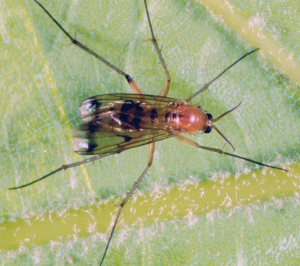Fungus Gnats

Something has been bugging us in the office lately, which might not be what you think. Over the last few months, a small infestation of Fungus Gnats has made our offices their home. Fungus gnats are small insects (1/8 to 1/10-inch-long) common in high-organic-matter houseplant soils that are kept moist. Typically, we don’t consider them a significant problem, but rather a minor pest; however, they can be a major pest in the greenhouse. Adults cause minimal plant damage, but females lay eggs that hatch into larvae that damage plants by root feeding. Larval feeding directly damages developing root systems and interferes with the ability of plants to absorb water and nutrients, resulting in stunted growth. This makes fungus gnats unique because the damaging life stage is located in the soil. Both adults and larvae may also spread plant pathogens.
Water and sanitation are both vital for controlling fungus gnats in houseplants. Fungus gnat larvae need damp conditions to thrive, so allowing your house plants to dry out more than usual will help reduce the population. The “dry” surface is less attractive to females, and even if eggs are deposited, they fail to hatch. Another cultural strategy is incorporating abrasive materials such as diatomaceous earth into growing media or applying it to the surface. Diatomaceous earth is composed of sharp skeletons of hard-shelled algae that form fossil deposits, which remove the cuticular waxes, absorb oils and waxes in the outer cuticle, or rupture the cuticle, causing dehydration. Scouting or monitoring is an essential component of pest management programs used to detect fungus gnats early, before populations build up to damaging levels. Yellow sticky cards near the growing medium surface are typically used for monitoring fungus gnat adults.
If fungus gnat populations have gotten high, the use of an insecticide is probably going to be necessary. The most effective treatments are those that are persistent, killing adults for up to three days. Several pyrethroid-based insecticides, with extended persistence, are available for use on houseplants, including those containing the following active ingredients: bifenthrin, cyfluthrin, and permethrin. Short-persisting contact insecticides such as those containing pyrethrins, soaps, oils, and neem do not provide sufficient long-term control of fungus gnat adults and require repeat applications at short intervals (a couple of days) to exhibit effects. Since the larvae are the life stage that directly causes plant damage, most insecticides are applied as a drench to the growing medium. Systemic insecticides are effective at killing the larvae, and products containing the microbial insecticide Bacillus thuringiensis subsp. israelensis (Bti), such as Mosquito Bits, when applied as a drench to the growing medium.

Have questions? Contact our office where our Horticulture Extension Agent will assist you with questions.
Phone: (316) 321-9660
Email: callae@ksu.edu